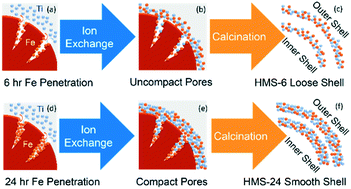当前位置:
X-MOL 学术
›
Catal. Sci. Technol.
›
论文详情
Our official English website, www.x-mol.net, welcomes your
feedback! (Note: you will need to create a separate account there.)
An ion exchange approach assembled multi-dimensional hierarchical Fe–TiO2 composite micro-/nano multi-shell hollow spheres for bacteria lysis through utilizing visible light†
Catalysis Science & Technology ( IF 4.4 ) Pub Date : 2018-03-05 00:00:00 , DOI: 10.1039/c8cy00078f Jeremy Koon Keong Ang 1, 2, 3 , Jestoni Song Mi Chua 1, 2, 3 , Zhong Jie Chang 1, 2, 3 , Zhengtao Li 1, 2, 3 , Hongwei Bai 2, 4, 5, 6 , Darren D. Sun 1, 2, 3
Catalysis Science & Technology ( IF 4.4 ) Pub Date : 2018-03-05 00:00:00 , DOI: 10.1039/c8cy00078f Jeremy Koon Keong Ang 1, 2, 3 , Jestoni Song Mi Chua 1, 2, 3 , Zhong Jie Chang 1, 2, 3 , Zhengtao Li 1, 2, 3 , Hongwei Bai 2, 4, 5, 6 , Darren D. Sun 1, 2, 3
Affiliation

|
The ion exchange approach demonstrates the fabrication of the hierarchical, multi-shell, micro-/nano, Fe–TiO2 composite hollow spheres (HMS). The synthesis mechanism elucidates a novel technique to achieve a Fe–TiO2 composite multi-shell structure by first allowing Fe ions to penetrate the pores of carbonaceous spheres at room temperature. This is followed by ion exchange in a solvothermal treatment. Lastly, the outward diffusion of the Fe ions allows the inward diffusion of Ti ions to fill the voids created within the pores of the carbonaceous spheres and simultaneously form hierarchical thorns. The ion exchange enabled a deeper penetration of Ti ions into the pores of the carbonaceous spheres. The oxidization of the carbonaceous spheres leads to the convergence of deeply penetrated Ti–Fe ions which crystallize to form Fe–TiO2 composite multi-shell spheres. The HMS spheres revealed an agglomeration of 20 nm nanoparticulates and a uniform dispersion of Fe–TiO2 composite. Increasing the Fe ion penetration duration from 6 h up to 48 h was found to gradually reduce the band gap from 3.1 eV to approximately 2.7 eV. The synthesis mechanism elucidates the compaction of metal ions within the pores of the carbonaceous spheres which leads to a smoother inner sphere morphology and, consequently, the reduction in the mesopores diameter from 15 nm to 4 nm. The HMS demonstrate an enhanced physical lysis of 40% bacteria under dark conditions owing to the hierarchical thorn-like structure and an enhanced bactericidal capability to 70% under the irradiation of visible light over a period of 1 h. The initial physical lysis by the hierarchical thorn surface to the cell and the subsequent release of reactive oxygen species to degrade the ruptured bacteria wall or access the RNA/DNA led to further cell death.
中文翻译:

离子交换法组装了多维层次的Fe-TiO 2复合微/纳米多壳空心球,用于通过利用可见光来裂解细菌†
离子交换方法演示了多层,多壳,微/纳米Fe-TiO 2复合空心球(HMS)的制造。合成机理阐明了获得Fe–TiO 2的新技术在室温下首先允许Fe离子穿透碳质球的孔,从而形成复合多壳结构。随后在溶剂热处理中进行离子交换。最后,Fe离子的向外扩散使Ti离子向内扩散,从而填充了碳球孔内形成的空隙,并同时形成了层状刺。离子交换使Ti离子可以更深地渗透到碳球的孔中。碳质球的氧化导致深穿透的Ti-Fe离子的会聚,这些Ti-Fe离子结晶形成Fe-TiO 2复合多壳球。HMS球显示出20 nm纳米颗粒的团聚和Fe–TiO 2的均匀分散合成的。发现Fe离子的渗透持续时间从6小时增加到48小时,可以将带隙从3.1 eV逐渐减小到大约2.7 eV。合成机理阐明了碳离子球孔内金属离子的压实,这导致内部球体的形态更平滑,因此中孔直径从15 nm减小到4 nm。HMS表现出在黑暗条件下40%细菌的物理裂解作用增强,这是由于其具有层次状的刺状结构,并且在1 h的可见光照射下具有70%的杀菌能力。最初的刺细胞通过分层的刺表面进行物理裂解,随后释放出活性氧,以降解破裂的细菌壁或进入RNA / DNA,导致进一步的细胞死亡。
更新日期:2018-03-05
中文翻译:

离子交换法组装了多维层次的Fe-TiO 2复合微/纳米多壳空心球,用于通过利用可见光来裂解细菌†
离子交换方法演示了多层,多壳,微/纳米Fe-TiO 2复合空心球(HMS)的制造。合成机理阐明了获得Fe–TiO 2的新技术在室温下首先允许Fe离子穿透碳质球的孔,从而形成复合多壳结构。随后在溶剂热处理中进行离子交换。最后,Fe离子的向外扩散使Ti离子向内扩散,从而填充了碳球孔内形成的空隙,并同时形成了层状刺。离子交换使Ti离子可以更深地渗透到碳球的孔中。碳质球的氧化导致深穿透的Ti-Fe离子的会聚,这些Ti-Fe离子结晶形成Fe-TiO 2复合多壳球。HMS球显示出20 nm纳米颗粒的团聚和Fe–TiO 2的均匀分散合成的。发现Fe离子的渗透持续时间从6小时增加到48小时,可以将带隙从3.1 eV逐渐减小到大约2.7 eV。合成机理阐明了碳离子球孔内金属离子的压实,这导致内部球体的形态更平滑,因此中孔直径从15 nm减小到4 nm。HMS表现出在黑暗条件下40%细菌的物理裂解作用增强,这是由于其具有层次状的刺状结构,并且在1 h的可见光照射下具有70%的杀菌能力。最初的刺细胞通过分层的刺表面进行物理裂解,随后释放出活性氧,以降解破裂的细菌壁或进入RNA / DNA,导致进一步的细胞死亡。











































 京公网安备 11010802027423号
京公网安备 11010802027423号